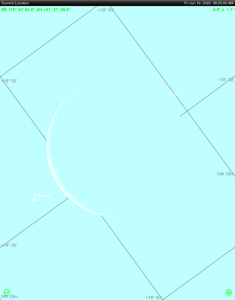2020 June 6
Observer’s Challenge – Occultation of Venus by the Moon, June 19

This month’s Observer’s Challenge is to observe a daylight occultation of Venus by the very thin (4% illuminated) crescent Moon on the morning of June 19.
The usual warnings about using binoculars and telescopes in daytime apply here. Never sweep around the daytime sky randomly while looking though the binoculars or telescope: be sure you are pointing the instrument nowhere near the Sun before looking through it, and, if you sweep, always sweep away from the Sun. With binoculars and portable telescopes, a good plan is to station yourself somewhere where the Sun is behind a building or other obstruction throughout the event.
The predicted times of the occultation (courtesy Tim Haymes) in BST are as follows:
| London | Aberystwyth | Edinburgh | Exeter | |
| First contact (Dark limb of Venus touches bright limb of Moon) | 08:38:54 | 08:35:40 | 08:41:29 | 08:33:55 |
| Centre of Venus’ disk occulted by bright limb of Moon | 08:40:00 | 08:36:42 | 08:42:28 | 08:34:59 |
| Second contact (Venus is entirely occulted) | 08:41:08 | 08:37:43 | 08:43:27 | 08:36:03 |
| Third contact (Dark limb of Venus at dark limb of Moon) | 09:41:40 | 09:40:42 | 09:48:25 | 09:37:17 |
| Centre of Venus’ disk clears dark limb of Moon | 09:42:51 | 09:41:47 | 09:49:27 | 09:38:25 |
| Fourth contact (End of occultation) | 09:44:01 | 09:42:53 | 09:50:29 | 09:39:33 |
(At first and third contacts, clearly, nothing will be seen to happen, but these numbers are given for completeness.)
Venus will also be a thin crescent, only 8% illuminated, and apparent size 51 arc seconds, so the crescent will be resolvable in binoculars. It will be magnitude -4.3 but probably not visible with the naked eye, unless you have exceptionally good eyesight and transparent skies. The Moon will not be visible to the naked eye, and whether it will be visible in binoculars and telescopes at this very thin phase, in full daylight, is questionable. Observers may be able to find it by finding Venus first; Venus will certainly be visible in all optical aid, owing to its high surface brightness and hence contrast with the blue sky. A red filter might help to reveal the Moon through a telescope, or, using an astronomical camera with infra-red sensitivity, an IR-pass filter.
The views as given by SkySafari for London 15 minutes before disappearance at the bright limb, and at the time of reappearance at the dark limb, are shown below:


To aid in finding, coordinates of Venus 15 minutes before disappearance, and at the time of reappearance (from London) are given below:
| Time (BST) | Azimuth | Altitude | R.A. | Dec. |
| 08:25 | 115º 18′ | 41º 22′ | 4h 19m | +18º 34′ |
| 09:42 | 137º 44′ | 51º 54′ | 4h 19m | +18 33′ |
As the Moon is likely to be hard, or impossible, to see in binoculars, it will only be (relatively) easy for binocular observers to observe the gradual disappearance of Venus, as, over an hour later, it will be hard to find the right place where Venus should reappear in the sky. When it does, the crescent will be revealed by the departing dark limb of the Moon over a minute or so.
Observers with driven, correctly-aligned telescopes stand the best chance of being able to monitor both disappearance and reappearance, as, if they get Venus in the field beforehand, it should still be in the field when it reappears from behind the Moon.
The challenge is to make any form of observation of this event at all, at either the disappearance or reappearance stage. We are not sure what you will see, because, as stated above, it is hard to predict whether the Moon will be visible. The observation could be a sketch of what you see at any stage, or an image of the two bodies very close together, or with occultation in progress, or a video, or timings of the event from your location. Please post your observation to your member’s page.
Take care, and best of luck!
| The British Astronomical Association supports amateur astronomers around the UK and the rest of the world. Find out more about the BAA or join us. |
